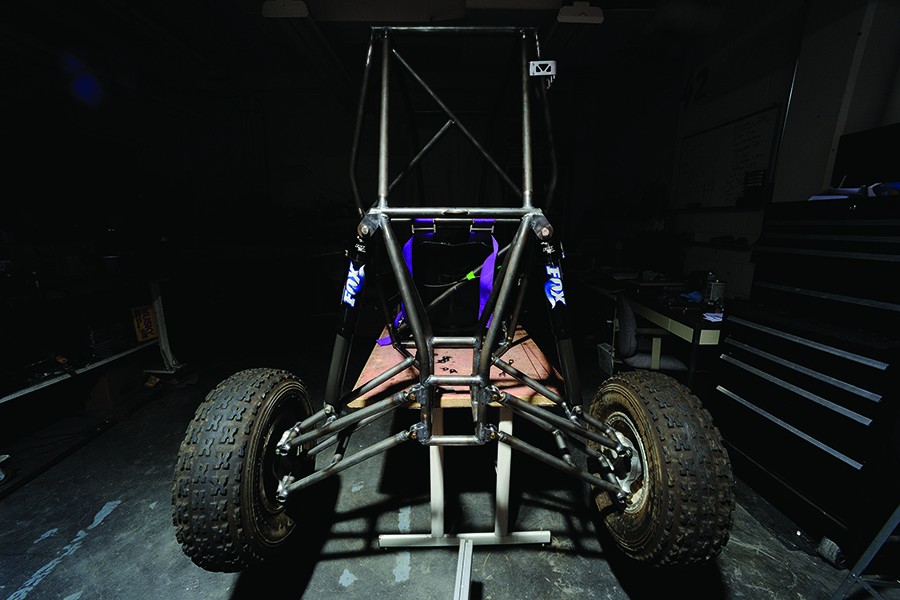The 2013 Hopkins Baja car started as theoretical points in space modeled on a computer. Next came 2D line drawings of a suspension. And then began the long road to assembly, with countless caffeine-fueled late nights in cold, cramped machine shops in Homewood's Latrobe and Krieger halls.

Image caption: Members of Hopkins Baja work on this years car in their Krieger Hall dedicated space.
Image credit: Will Kirk / Johns Hopkins University
There's nothing like sparks flying off metal at 3 a.m. or falling asleep on a jigging table.
But how can this baby handle?
We'll soon find out.
The Hopkins Baja team, a group of undergraduates bonded by a love of gears and transmissions, builds each car from scratch, no kits and no directions.
They begin to manufacture the vehicle's frame during winter intersession. A bundle of 20-foot chrome alloy steel bars arrives from an aircraft supply company. The bars are cut down, twisted, and welded in the team's dedicated space in 60 Krieger.
Here they mock up the pedals, steering wheel, gearbox, transmission, and just about every part of the 370-pound off-road vehicle, akin to a miniature dune buggy. The only parts they don't build are the tires, seat, shock absorbers, and engine, a 10-horsepower Briggs & Stratton model.
As of press time, the Baja car was still taking shape as the team raced against the clock to tighten the final screw.
The first competition of the season will take place April 18 to 21, a Baja SAE series event hosted by Tennessee Tech University. Hopkins Baja will race again in mid-June at the Rochester Institute of Technology in the final leg of the 2013 SAE series.
The signature event of each competition is a four-hour endurance race over a body-jolting dirt course.
Last year, the team finished ninth out of 104 teams at the event in Auburn, Ala. Not bad for a car that didn't get road-tested before the race and had a CVT cover fall off mid-race, causing a 45-minute delay while team members scoured the course looking for it.
In the race to the finish line, Johns Hopkins is chasing such universities as Cornell, Michigan, and a number of French-Canadian technical schools—namely Baja race giants Université Laval and École de technologie supérieure—where students can major in automotive or manufacturing engineering.
"Some of these schools have entire courses focused on vehicle composites and body panels, and PhD professors in automotive engineering," says Andrew Kelly, a senior in Mechanical Engineering and this year's team captain. For 2013, the 15-member Hopkins Baja team aimed at crafting the school's smallest and lightest car to date.
"We have a smaller frame, which I think is beautiful. We use a fiberglass seat and thin aluminum for the steering wheel. We want to make it as light as you can without having to make the individual parts too big for the competition."
The Hopkins Baja car also features a removable gas tank for easy fill-up at pit stops.
Kelly says that just finishing the race is an accomplishment. The start of Baja races is often chaos. Some cars break immediately. Others slowly deteriorate.
Hopkins Baja members joke that if you've designed the car perfectly, it will fall apart right after the checkered flag. "Like a marathon runner, you want to crash at the finish line," Kelly says.
The JHU team has solidified itself in the top 10 annually and now has its sights set on a top-five finish.
The students do it for the love of the sport, and the engineering challenge.
"We receive no credit for this. We're not getting paid. No faculty come down here to applaud our work," Kelly says. "I do it because I love cars. I love the small details and seeing the whole project come together. It just consumes you."
Gentlemen and lady (the Hopkins Baja team has one female member), start your engine.
Posted in Science+Technology, Student Life
Tagged mechanical engineering








